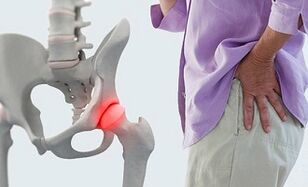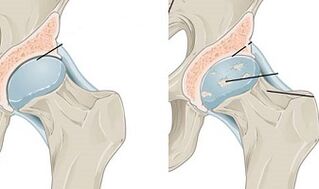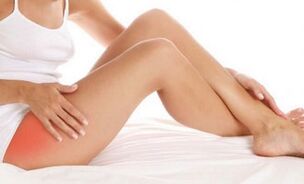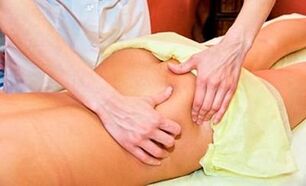
Our body is a complex system in which the disintegration of a "screw" causes the failure of other "components". In addition to diseases of the internal organs, the musculoskeletal system, especially chronic diseases of the joints, also cause many problems. Today, I make a proposal to discuss hip arthrosis. What are the symptoms and recommended treatments.
This joint is the largest in the human skeleton. It is used constantly when walking, bending, turning, so the disease brings severe pain and stiffness to the patient. Fortunately, with an early diagnosis, the disease is well treated with medication. But it is not so easy to suspect that something is wrong, you need to know all the features of the disease, and you should be able to recognize the first manifestations. And of course, beware of ways to prevent it, and our article will help.
Hiprosis or arthrosis of the hip joint is also called coxarthrosis, these terms mean one thing - a complex progressive disease with the destruction of cartilage covering the head of the femur and the acetabulum. As a result, the joint gradually collapses, becomes bone, heals, and loses its mobility.
Coxarthrosis - what is it
Let's take a closer look at what coxarthrosis is, as the term is often used by doctors, as the word "arthrosis" was recently excluded from medical terminology because it was previously thought to have nothing to do with inflammation, but later scientistsproved otherwise. For us, these debates are not important, the point is that these names refer to the same very unpleasant disease.
So, coxarthrosis is a degenerative-dystrophic disease that causes the destruction and deformity of cartilage tissue. It is mainly diagnosed in women over the age of 40 and 60 in men.
Why is it as injustice as ladies before nature? The point here is the special structure of the female skeleton and the load on the hip joint, especially during childbirth and childbirth. As a result, middle-aged women are more likely to suffer from this disease, and the number of patients of different sexes in the older age group is gradually leveling off.
Causes of hip arthrosis
There can be several causes of hip arthrosis.
The most common of these are
- Inheritance, if the parents or one of their relatives has suffered from such a disease, they should pay more attention to their health, because although the disease itself is not related to genetics, the predisposition to metabolic disorders and other disorders can cause joint problems;
- heavy load in the pool, especially for running, jumping, weightlifting athletes;
- Obesity, even mild weight gain, can be negative for the joints, causing an increased load on them, making obese people more prone to arthrosis;
- injuries, fractures, pelvic bruises;
- Endocrine disorders such as diabetes can cause bone problems;
- inflammatory, infectious processes in the body, such as purulent or rheumatoid arthritis;
- problems with the spine or bones (flat legs, scoliosis, osteochondrosis) that change the posture and stress of the joints;
- hormonal imbalance;
- weakening of blood circulation in tissues;
- sedentary lifestyle;
- old age, which is associated with deterioration of tissue nutrition.
Degree of Coxarthrosis
Doctors differentiate between 3 degrees or the stage of the disease, which helps to differentiate between the main symptoms. It is important to know that when diagnosing stage 1, it is entirely possible to completely cure the disease and forget about it for many years, and in stage three, the only correct decision will be surgery, otherwise the patient is at risk of disability.
Section 1
The following symptoms help determine the presence of grade 1 arthrosis in the hip joint:
- pain during and after severe joint strain;
- localization of pain only in the area of bone junction; The walk of
- does not change;
- no lameness; The
- muscles retain their strength and shape.
During computer diagnostics, the doctor may notice bone growth on the surface of the joint, especially along the inner and outer edges of the acetabulum. At this stage, properly selected medications allow for complete restoration of joint performance, but not all of them tend to rush to the doctor when the first manifestation of pain.
Admit it, a little discomfort often makes you think about stretching, shifting, and tired. We start rubbing the sore place with various creams and ointments, we try to heal them by folk methods, without understanding the cause and wasting precious time. Therefore, if you feel pain in your leg, the first thing is to consult a doctor, set aside some time for yourself - this is the key to a long, full and happy life!
Section 2

If the problem is not diagnosed and treated immediately, Grade 2 arthrosis gradually develops with the following symptoms:
- more common pain that may occur with inactivity;
- pain is no longer limited to the area of bone contact, but radiates to the hips, groin, back;
- movements become limited, the person is unable to move his leg completely to the side;
- paralysis appears.
During the study, images show bone growth at the edges of the cavity, bone tip growth, displacement, and edge destruction.
Fortunately, with the help of complex therapy, grade 2 arthrosis is still a conservative treatment.
Section 3
Well, this is very bad for patients who have neglected their health so much that III. stage arthrosis, it is characterized by:
- day and night pain, even without physical exertion;
- the need to use a crutch or walking stick;
- atrophy, ie shortening of the muscles of the patient's leg, change in posture.
During the examination, the doctor sees a number of bone growths, an increase in the size of the bone edge, and a decrease in the joint space. And there’s only one way out here - it’s an operation that replaces an already unusable joint with a special artificial prosthesis.
Signs
We have already briefly mentioned the symptoms of the disease, a summary of these symptoms remains.
Coxarthrosis manifests itself:
- severe pain in the joint that may later radiate to the foot, groin, knee;
- movement disorders, difficulty walking without support;
- Abbreviation for patient limb;
- poor posture;
- decreased range of motion in the affected joint;
- X-ray shows muscle atrophy;
- MRI shows abnormalities in soft tissues, inflammation;
- CT shows the presence of bone growths.

The symptoms are clear, but not so clear. Therefore, with one of these signs, a specialist should be consulted to make a diagnosis, as it can be both arthrosis and completely other diseases with similar symptoms.
Diagnostics
Diagnosis of the disease should be done by several doctors because pelvic pain can cause various diseases.
Thus:
- the therapist may find chronic conditions that cause hip discomfort;
- a neurologist rules out or confirms the presence of intervertebral hernias, sometimes causing the same symptoms that are characteristic of arthrosis;
- urologist checks men for prostatitis, these diseases often cause pain in the pelvis, radiating to the legs;
- the gynecologist is looking for adhesions in the patient, their manifestations are similar to this disease;
- a rheumatologist who specializes in solving such problems can help determine the stage, causes, and methods of treating the disease;
- The surgeon and orthopedist will be very helpful in the advanced stage when the patient needs surgery.
This way, in order to make a correct diagnosis, you can't just limit yourself to a doctor's visit, and you'll also need to take tests:

- Clinical and biochemical analysis of urine and blood for inflammation of the body;
- MRI for soft tissue examination;
- CT to examine the bones; X-rays of
- show bone damage;
- arthroscopy is indicated in some cases;
- Sometimes ultrasound is needed in the pelvic organs.
The success of treatment depends on the correct diagnosis, the degree of damage and the cause of the deformity. For example, if osteoarthritis caused bone tuberculosis, standard therapy is prohibited, and in the case of metabolic abnormalities, the cause must first be eliminated and then its consequences addressed.
Treating hip arthrosis
The most effective treatment is in the early stages, you can limit yourself to different medications. How to treat inflammation - your doctor will decide after a series of studies. Therapy is highly dependent on the cause and degree of death, but they are mainly used to relieve pain, remove inflammation, and improve blood circulation: it is used for this purpose:
- non-steroidal anti-inflammatory drugs;
- painkillers to return the patient to a normal life and make walking easier;
- muscle relaxants to restore blood circulation in the diseased area of the body;
- chondroprotectors to help stop cartilage deformation;
- steroid injections are used when pain increases;
- vasodilatory drugs.
In addition to tablets, injections and ointments, treatment includes the use of special diet and exercise therapy, a package of measures to help significantly improve the condition and restore leg mobility.
Surgery
If conservative treatment does not produce visible results or the disease has been diagnosed in the last stage, there is only one way out - it is a surgery. The procedure is complicated, in rare cases the rejection or risk of thromboembolism and other fatal complications is possible. However, for severely ill patients, this is the only chance to lead a normal life, because with an artificial joint, after healing and rehabilitation, one can move freely.
As with any procedure, a patient with coxarthrosis should be prepared for general anesthesia in advance, should not eat or drink before the procedure, and should have their bowels cleansed. The leg is then wrapped in elastic bandages to avoid edema, laid to the side and fall asleep. The doctor then makes an incision in the thigh, opens access to the joint, cuts off the head of the femur, and inserts a pin into the incision to which the titanium head is attached.
Damaged pelvic bone tissue is also removed and replaced with a polymer pad to allow normal movement of the foot in the future. The wound is then sutured and a bandage is applied on top. There is still a healing period after healing, but in the absence of rejection, a person can walk for 20 years or even a lifetime, walk calmly with a wrist, feel pain and stiffness.
Chondroprotectors
Due to the disease, the hip joint loses its mobility, tissue changes, cartilage destruction and bone growth in place are observed. Fortunately, effective drugs have been invented to repair cartilage tissue, also called chondroprotectors, which in Latin means "cartilage protection. "
So what are these drugs capable of?
- stop the process of cartilage tissue destruction;
- speeds up metabolism in the joint;
- stimulates the production of synovial fluid, i. e. , the natural lubrication that is normally produced in cartilage tissue and promotes easy sliding of bone in the joint;
- relieves inflammation;
- facilitates joint movement.
Preparations may contain two main ingredients - glucosamine and chondroitin.
As for the form of the medicine, it can vary from tablets, capsules, ointments, creams to solutions for injection. The choice of drug, dosage and duration of administration should be prescribed by the treating physician, taking into account the characteristics of the body. But usually the injections are used during exacerbations and then the patient is transferred to a more gentle treatment that can last for months, at least six months. After all, restoring cartilage tissue is a long process, but it allows you to return to freedom of movement without surgery.
Injections
In some cases, the treatment of the disease involves injections. They can only be performed by a doctor, and only in extreme cases do they resort to such a solution, as treating the disease in this way is risky. The fact is that the gap between the bones of the hip joint is small and narrows even more in the case of coxarthrosis. As a result, sometimes even an experienced doctor does not get into the joint capsule itself and there is a high risk of contact with the nerves and blood vessels.
However, injections are sometimes the only way to relieve pain and inflammation; different drugs are used for these purposes:
- corticosteroids for analgesia, such injections may be given up to every two weeks and up to 7 courses may be given;
- chondroprotectors help tissue repair, stimulate the production of synovial fluid for normal bone slippage, and improve tissue elasticity. In the form of injection, drugs act faster than tablets or ointments, allowing the drug to be delivered directly to its destination;
- hyaluronic acid is the latest method to relieve inflammation and pain. It is used after all other drugs have been tried and has not achieved the desired result, the effect of its use is long lasting, the injection is given once.
Physiotherapy
Unfortunately, in the fight against hip arthrosis, physiotherapy procedures are ineffective due to the deep location of the affected area. However, sometimes doctors prescribe kinesiotherapy to relieve pain.
Massage

Performing a medical massage by a professional improves blood circulation in the joint, restores mobility, and stops tissue destruction. But its use is indicated only during remission, in the absence of pain.
In order to achieve a clear effect, it is not necessary to visit a specialist once, but to take courses two or three times a year to maintain the condition of bones and joints.
Treating Coxarthrosis with Folk Remedies
Although it is quite difficult to completely cure hip coxarthrosis using folk remedies alone, especially in severe, advanced forms, even doctors recognize the effectiveness of natural remedies. Many preparations based on herbs, roots and essential oils significantly alleviate the condition of a sick person, stop the destruction of cartilage and the formation of bone and scar tissue, stimulate the production of joint fluid, which is very important in the fight against the disease.
In order to achieve the most effective and positive treatment result, it is worth discussing with your doctor what alternative methods can be used on your own at home.
The most popular tools are
- perestroot ointment. To prepare it, the root should be crushed in a coffee grinder, mixed with lard melted in a ratio of 2: 3, boiled on low heat for five minutes, cooled and smeared with the composition of the sore spot for one month in the evening. Then rest for a week and continue treatment;
- ointment with celandine - dry 7 plants, separate the leaves from the stems and chop, pour 1 cup olive oil, leave in the cold for 14 days, then the drug becomes gelatinous and melts in your hands. Lubricate the sick area with some substance every night;
- birch leaves, linden flowers, parsley dry, chop, cook instead of tea and drink every day;
- Wash the lemon, chop and add 1 liter. boiling water, after a few hours filter, add honey, drink three times a day;
- combine honey, iodine, ethyl alcohol and glycerin in equal amounts, leave for 3-4 hours, lubricate the skin three times a day with a cotton ball;
- take 60 grams of cinquefoil and elecampane roots, mix with 0, 5 liters. vodka, stick for a day in a dark and cool place, strain, drink 25-30 drops three times a day 30 minutes before meals, you can also use for rubbing.

Exercises for Hip Coxarthrosis
Specially selected exercises can significantly improve the condition of coxarthrosis, some of which are recommended by your doctor. You should consult your doctor before using them, as the presence of an incorrectly selected complex and contraindications can cause even more damage to your health.
For example, deforming arthrosis is dangerous to treat with physical activity - it causes even more pain and tissue damage.
Thetournament is also prohibited if:
- exacerbation of the disease;
- obvious pain in movement;
- increased body temperature;
- exacerbation of chronic diseases;
- menstruation;
- hernia;
- severe heart and lung disease.
It is believed that therapeutic practices for coxarthrosis should focus on restoring muscles and ligaments, but not on loading an already weak joint, so static movements rather than dynamic ones are more appropriate. I am also pleased that the exercise series can be carried out at any time without spending money and nerves on the path of professionals, and given their effectiveness, it will simply be a crime not to use such a universal medicine.
Here are some exercises:
- lying on your back, lift the affected leg 10-15 cm, frozen for 20-30 seconds, repeat the other leg;
- perform the same movement, but quickly, holding your feet for only 1-2 seconds;
- so as not to raise a straight leg, but a leg bent at right angles to the knee;
- lying on your stomach, tear your legs off the floor and hold for a few seconds, slowly spread to the sides, rejoin, lower to the floor;
- lying on your side, bend your lower leg, lift your upper leg and hold it at an angle of about 45 degrees, wait 30 seconds, return to starting position, repeat the other leg;
- Perform the previous exercise, turning the leg up and down alternately.
True, it is not recommended to practice only when describing exercises and videos, it is better to discuss this point with a doctor or even visit a rehabilitation specialist several times, as the complex needs to be adjusted to avoid complications in other types of illness.
Nutrition
Because osteoarthritis is highly dependent on metabolism, it is important to follow a proper diet when treating the disease. It should be common, but not plentiful. Excluded:
- salty foods;
- fatty broths, mayonnaise, oils, dairy products (sour cream, sour cream);
- preservatives;
- baked goods made from premium flour;
- smoked.

These should be replaced with cartilage:
- Milk and low-fat dairy products, especially cheese, are very important as they promote tissue regeneration and calcium absorption;
- lean fish and meat;
- beans, mushrooms, buckwheat, lentils rich in vegetable protein;
- jelly meat, jelly fish, jellies containing collagen; carbohydrates derived from cereals;
- vegetables, fruits;
- complex carbohydrates (dried fruits, honey).
A lot of fluid intake is important to maintain salt balance.
Proper nutrition helps remove uric acid, which is dangerous to the joints, relieves inflammation, removes excess weight, edema, and thereby reduces the strain on the diseased area and even restores cartilage tissue. The greatest effect can be achieved in stage 1 of the disease.
Prevention
If you have a family history of illness, or if hip arthrosis is already present and can be successfully treated, it is important to have proper and regular prevention, which consists of the following points:
- proper nutrition that contains all the vitamins and minerals for normal tissue metabolism;
- weight control to avoid additional loads;
- Reduction of physical activity, ability to move injured and avoid strain on diseased joints;
- Beware of hypothermia as it may aggravate it. It is important to dress warmly, cover the pool in cold weather, avoid sitting on cold surfaces and drafts;
- lead a healthy lifestyle, walk in the fresh air, carefully strengthen our leg muscles.
Osteoarthritis is a very unpleasant disease that, without proper treatment, results in bone fusion disability and wheelchair life. Therefore, for the first symptoms, consult a doctor for diagnosis and help. Timely and comprehensive treatment allows you to get rid of the problem and live without pain and limitations.























